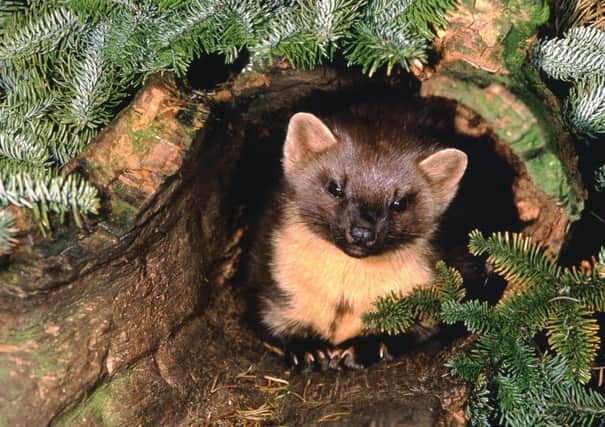Pine martens back from brink in south of Scotland


But now, the shrill cat-like call of the pine marten can be heard once more, according to a new report which reveals the species is enjoying a revival across the south of Scotland.
The elusive members of the weasel family, instantly recognisable by their creamy yellow throat bib, are starting to recolonise areas of the mainland after an absence of nearly two centuries, researchers have found.
Advertisement
Hide AdAdvertisement
Hide AdA study by Scottish Natural Heritage (SNH) in collaboration with the Vincent Wildlife Trust (VWT) discovered three populations in the south-west of the nation – the Upper Tweed Valley; and in Annandale and Eskdalemuir in eastern Dumfries and Galloway.
Such is the resurgence of the once rare creatures, the nation’s heritage watchdog has issued advice to homeowners in case some of the rare creatures happen to take up residence in lofts and roof spaces.
It heralds a remarkable revival for the pine marten. Once found throughout the UK, the species suffered one of the most dramatic declines of any UK mammal.
Woodland clearances, trapping for fur, and predator control by gamekeepers led to a widespread decline in numbers in the 19th century.
By 1915 they existed only in remote pockets in the north-west Highlands.
Indeed, the species is still rare in the UK and is absent from most of England and Wales. In 1988, it was given full legal protection under the Wildlife and Countryside Act, a step which has helped contribute to its gradual yet encouraging upturn in fortunes.
As well as southern Scotland, they are being found in and around the central belt, while the species has also been spotted on the Isle of Skye after the bridge was built and, more recently, in Mull.
Lizzie Croose, the VWT’s survey co-ordinator, said: “The pine marten is the first mammalian predator which almost became extinct in the 19th century to make a substantial recovery in Scotland
Advertisement
Hide AdAdvertisement
Hide Ad“Pine martens have been absent from most of southern Scotland for almost 200 years so their return is significant.”
A small number of pine martens were reintroduced to the Galloway Forest in the early 1980s, but the new arrivals are not thought to have spread from this group, which has remained in isolation.
Instead, researchers believe the new populations have most likely originated from a combination of natural spread and deliberate releases.
The information on the pine martens in new areas comes from a recent survey, in which pine marten droppings were collected from woodlands and subjected to DNA analysis to confirm their origin.
Records of pine martens were also collected from foresters, naturalists and local record centres.
It is estimated there are now between 2,600 and 3,500 pine martens living in Scotland.